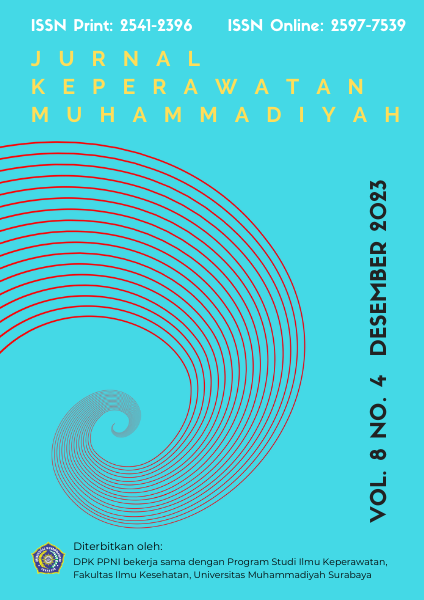Model Blended Learning Pendekatan Contextual Teaching Learning (BLCTL) Pada Mata Kuliah Keperawatan Dasar Bagi Mahasiswa Keperawatan
Keywords:
Blended Learning, Contextual Teaching Learning, NursingAbstract
Objective: The competencies of nursing education graduates that are of concern are basic nursing knowledge, collaboration skills, and adaptive thinking. The efforts to overcome these competencies are through learning that can construct knowledge, encouraging collaboration and adaptive abilities. The process of constructing knowledge, collaboration and adaptive skills can be got from two learning models, namely face-to-face and e-leaning, with emphasis on contextual aspects, collaborative and adaptive elements. This research aims to analyze the feasibility of a blended learning model with a contextual teaching learning (BLCTL) approach in learning basic nursing courses for nursing students.
Methods: research and development was used in this study, using the Dick and Carey Model, with a sample size of 104 selected using simple random sampling from students in the Nursing Program at Muhammadiyah University, Surabaya. Data was collected at the model needs analysis stage using for and observations, the development stage using questionnaires, the implementation stage using tests and observations.
Results: The research results show that the BLCTL model is a learning model that is suitable for the learning process with a learning syntax comprising 5 phases, namely constructivism, questioning and inquiry, learning community, modeling, and authentic assessment and reflection. With the results of the model feasibility test on the learning model aspect 97.1%, RPS learning device aspect 97.9%, media device (e-learning) 96.6%, textbook device 95.8%, knowledge assessment and collaboration device 100%.
Conclusion: The BLCTL model involves students in the learning process, which identifies previous knowledge and learning experiences for the learning activity process. By emphasizing actual conditions and existing characteristics, this model is very relevant to learning in nursing education and the development of information technology to create an adaptive learning system.
References
Bada, S. O., & Olusegun, S. (2015). Constructivism learning theory: A paradigm for teaching and learning. Journal of Research & Method in Education, 5(6), 66-70.
Bressington, D. T., Wong, W.-k., Lam, K. K. C., & Chien, W. T. (2018). Concept mapping to promote meaningful learning, help relate theory to practice and improve learning self-efficacy in Asian mental health nursing students: A mixed-methods pilot study. Nurse Education Today, 60, 47-55. https://doi.org/https://doi.org/10.1016/j.nedt.2017.09.019
Degeng, I. N. S., & Sudana, N. (1989). Ilmu pengajaran taksonomi variabel. Depdikbud.
Dick, W., Carey, L., & Carey, J. O. (1996). The systematic design of instruction. Pearson.
Durmuş, S. Ç., Ekici, D., & Yildirim, A. (2018). The level of collaboration amongst nurses in Turkey. Int Nurs Rev, 65(3), 450-458. https://doi.org/10.1111/inr.12440
Dwiyogo, W. D. (2013). Pembelajaran berbasis blended learning. Tersedia: http://id. wikibooks. org/wiki/Pembelajaran-Berbasis-Blanded-Learning.[01 Januari 2017].
Hidayat, A. A. A., & Uliyah, M. (2018). Analysis of nursing diagnosis using an expert system in paediatric patients. International Journal of Civil Engineering and Technology (IJCIET), 9(8), 17-26.
Johnson, A. P. (2014). Humanistic learning theory. Education psychology: Theories of learning and human development, 1-10.
Lucyda, H., & Vionalisa, V. (2019). Kolaborasi Perawat Dokter di Ruang Rawat Inap Rumah Sakit Umum Daerah Arifin Achmad Provinsi Riau. Jurnal Kesehatan Komunitas, 5(3), 235-240.
McCutcheon, K., Lohan, M., Traynor, M., & Martin, D. (2014). A systematic review evaluating the impact of online or blended learning vs. face-to-face learning of clinical skills in undergraduate nurse education. Journal of Advanced Nursing, 71(2), 255-270. https://doi.org/10.1111/jan.12509
Mustaji. (2017). Model dan Desain Pembelajaran; Teori dan Implementasi Problem Based Learning dan Collaborative Learning. Unesa University Press.
Rosenberg, M. J., & Foshay, R. (2002). E‐learning: Strategies for delivering knowledge in the digital age. Performance Improvement, 41(5), 50-51.
Rusman, D. K., & Rivana, C. (2011). Pembelajaran Berbasis Teknologi dan Informasi. Jakarta: PT Raja Grafindo Persada.
Shorey, S., Kowitlawakul, Y., Devi, M. K., Chen, H.-C., Soong, S. K. A., & Ang, E. (2018). Blended learning pedagogy designed for communication module among undergraduate nursing students: A quasi-experimental study. Nurse Education Today, 61, 120-126. https://doi.org/https://doi.org/10.1016/j.nedt.2017.11.011
Suharsimi, A. (2006). Prosedur penelitian suatu pendekatan praktik. Jakarta: Rineka Cipta.
Uliyah, M., Nurlaela, L., Hidayat, A., & Aziz, A. (2019). Using of Blended Learning in Improving Collaboration Skill of Nursing Students. Indian Journal of Public Health Research & Development, 10(9).
Wang, Y., Wan, Q., Guo, J., Jin, X., Zhou, W., Feng, X., & Shang, S. (2018). The influence of effective communication, perceived respect and willingness to collaborate on nurses' perceptions of nurse–physician collaboration in China. Applied Nursing Research, 41, 73-79. https://doi.org/https://doi.org/10.1016/j.apnr.2018.04.005
Widoyoko, E. P. (2009). Evaluasi Program Pembelajaran. Pustaka Pelajar
Downloads
Published
Issue
Section
License

This work is licensed under a Creative Commons Attribution-ShareAlike 4.0 International License.
- Penulis tetap memegang hak atas karyanya dan memberikan hak publikasi pertama kepada jurnal ini yang secara simultan karya tersebut dilisensikan di bawah:Â Creative Commons Attribution-ShareAlike 4.0 International (CC BY-SA 4.0)













